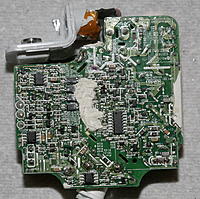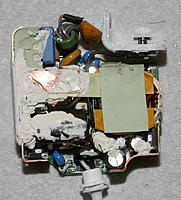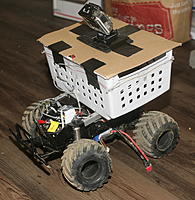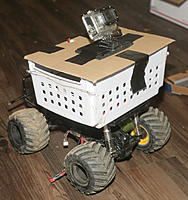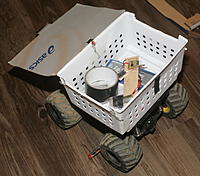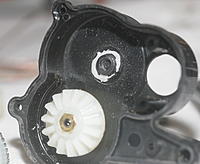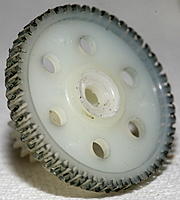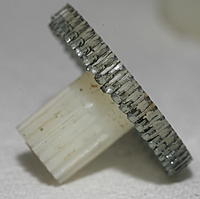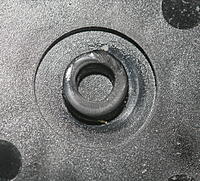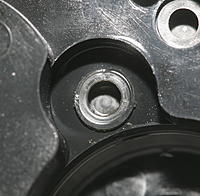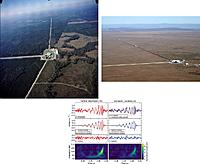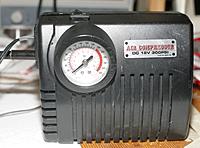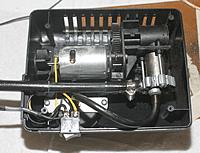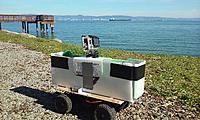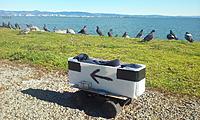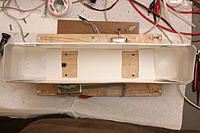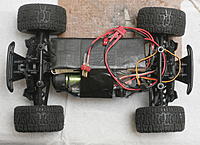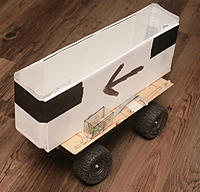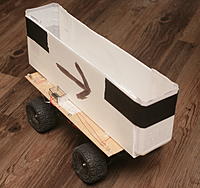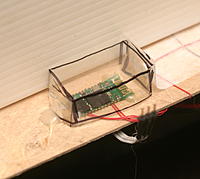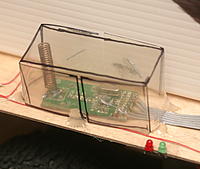Posted by Jack Crossfire |
Feb 27, 2016 @ 08:41 PM | 7,347 Views
In the search for a way to power 2 19V devices from 1 brick, it was finally time to tear one down. It was possible to get in by prying the enclosure apart, rather than grinding through it. There was a minimal amount of adhesive. Helas, there was not enough room inside the enclosure to solder a 2nd wire. The best way to split the output was not to break it open.
What was discovered was it doesn't require a macbook to turn on. It's off with no load. It outputs 17V when provided a load. An ESC was enough. The Accucell 8150 was enough. When powering the laptop, the laptop embeds data on the power line which causes the brick to adjust voltage depending on the load. A high CPU load makes it output up to 19V. A low CPU load makes it output 17V. This allowed Apple to get a constant voltage to the laptop through the minimum wire guage. Without the laptop on 1 end, it outputs 17V with the least load, sagging to 16V with increasing load.
It wouldn't be able to power the Accucell & laptop during full CPU usage. That would make it go above the Accucell's voltage limit to keep the laptop even. It also has very little reserve at full CPU usage. Any significant power usage makes it turn off.
Didn't document the powerline data chips because that wasn't the focus of the day. Being able to power a 19V fan & laptop from 1 brick is a huge savings in luggage.
Posted by Jack Crossfire |
Feb 27, 2016 @ 03:08 AM | 6,949 Views
It was named after the price per unit: $21 billion with a B. It's finally cheaper to rebuild the entire country from scratch & regrow all the people than it is to defend it. It would be a lot more fun to regrow all the people, anyway.
It wasn't ordered as a black project because they're broke & needed approval for more money. It may also be a way of keeping the contractors employed more than to fill any need. With only 1 dedicated military plane being ordered every 30 years, it's now a major announcement to order anything no matter how identical to the B-2 it is. The lack of evolution from the B-2 shows how the flying wing may be the ultimate design for anything in the atmosphere.
The rendering conspicuously lacked any engine exhausts, hid the exact shape of the engine intakes, & didn't give any size dimensions. It definitely has windows for a pilot. At least it showed the rendering may not represent reality at all.
Posted by Jack Crossfire |
Feb 24, 2016 @ 02:46 AM | 6,990 Views
All the talk of motor braking brought up the subject of springs in legged walking robots. Springs are a popular topic in legged robots. The human body is modeled after springs which restore energy in the walking cycle. Actually, the human leg doesn't restore energy. Gravity extends the muscles, but all the energy required to contract the muscles in 1 cycle needs to be expended again in the next cycle. There is no restoration of energy in a human, but adding springs to robotic legs improves their efficiency.
Nevertheless, motors are very good at recovering the kinetic energy of a wheel. Not only can they stop wheels, but enough energy is recovered to recharge the battery & restart the wheels. An electric car in traffic is basically an electric spring with a small amount of energy added in each start to what is recovered in each braking.
Surely there is a way to replace the springs in the most efficient walking robots with some kind of regenerative braking & this mechanism could make legged mechanisms almost as efficient as wheels. It would be best realized in high voltage linear motors, but a good experiment would be trying to make a common brushless outrunner act like a spring with some kind of actively controlled capacitor, then measure the torque this mechanism can provide.
It probably could make a lot more torque with the capacitor mechanism than a motor driven straight from a battery. The capacitor could be charged to a very high voltage, pulsed through the motor to generate the 1st motion, then each subsequent motion would require a small topping off.
A legged robot driven by regenerative spring motors might be more efficient at running, but not at standing still.
Posted by Jack Crossfire |
Feb 22, 2016 @ 11:18 PM | 6,981 Views
It was an intense series of firmware flashes, with full time heading hold followed by another simonk which brakes during idle (MOTOR_BRAKE = 1). Braking during idle finally solved the runaways when the tachometer died when going downhill & made driving in the city a bit easier.
With avrdude installed in /usr/local/bin, the command was
avrdude -e -patmega8 -cstk500v1 -P/dev/ttyACM0 -b19200 -Uflash:w:tp_8khz.hex:i -Ulock:w:0x0F:m
The trick is some point in its history, the dude changed to setting a custom baud rate for all baud rates including 19200, despite the fact that custom baud rates were unavailable in some kernels. It needed a hack to re-enstate the standard baud rate flag.
Also, /dev/ttyACM is non functional in virtualbox. It was functional for a JLINK debugger in native mode but not an Arduino. The arduino only worked for Linux 3.19 in native mode, but only after running another terminal program to initialize it to 19200 baud.
It's disappointing how much no longer works in Linux that used to work long ago. The stack postings for Linux drop off after the 2013 time frame, when smartphones dropped below $100. With waning use of desktop operating systems & programming becoming the fast food service of the 21st century, the desktop is returning to a time when weekly reboots were required.
Phones have always needed Windows 3.1 style dropkicking, but the kind of people who use them & who comprise the fast food age of programming don't care about breaking uptime records like 20 years ago.
Posted by Jack Crossfire |
Feb 17, 2016 @ 11:08 PM | 6,746 Views
25 minutes of barely usable footage from 67 min of running. The obsolete gopro did what it could in backlit darkness. The difficulty of the terrain made quad copters look real good. They could provide 15 minutes of higher quality footage, but a modern quad copter with the full brushless gimbal would be too big. Cargo capacity was the game changer for the lunchbox. A quad copter with cargo capacity would have to be huge & much noisier than the lunchbox, indeed.
Practical limitations aside, a quad copter controlled like the lunchbox, in a large enough space to be practical, would bring a new world of video quality.
The search continued for a rationale to make a wireless audio input for a phone. The athlete mounted microphones could be useful if there was no camera robot. The camera robot may be quiet enough at head distance to be usable. Testing the audio quality of an athlete mounted microphone by using the simplest mono phone input is the word.
Posted by Jack Crossfire |
Feb 15, 2016 @ 08:12 PM | 6,781 Views
The Zoom H2 has served for 7 years, showing growing limitations. Its battery life was never there. It never had a true microphone preamp. It didn't have any gain control. It's too big to do far less than a modern phone can do. It didn't have balanced inputs. Its user interface was utter trash.
The news of the day is the need for a very compact audio recorder which relies on a phone for the storage & user interface. There are many applications of this compact audio recorder.
1) Recording ambient sound in stereo from unbalanced electret microphones attached to an athlete.
2) Recording voice from an unbalanced headset or lav mic.
3) 3 unbalanced channels, with voice mic on 1 channel & ambient mics on 2 channels.
4) Recording balanced sound from 2 studio mics.
In all applications, it needs a headphone out to monitor the audio. It requires 4 preamps & 4 ADCs to capture all the required audio. 2 ADCs would be subtracted in software to capture balanced audio. Then it needs 2 headphone amps to power the headphones. It requires many digital pots:
4 - each preamp
2 - headphone out
The pots would be ganged for the user interface into 1-2 input gains & a single output gain. It needs presets to select configurations of preamps to record & pass to the headphones. It would be easiest to pass the digitized signal to a cheap DAC to drive the headphones.
Encoding needs to be 24 bit 48khz uncompressed. The total bandwidth would be
...Continue Reading
Posted by Jack Crossfire |
Feb 15, 2016 @ 01:18 AM | 7,406 Views
Fitted the lunchbox with a lid, onto which was mounted the camera. This stayed shut nicely, but the camera had quite a bit of vertical flopping. The trail was supposed to be easier, but once again proved too difficult. Any downward slope sent it flying down at full speed when the tachometer failed to register any motor speed. Ruts & drainage ditches were impassible. It was too noisy. Slowed it down to 6mph to reduce the noise. Only some flat areas at the bottom of the canyon were passable.
After 5.7 miles, the transmission blew & the motor spun like mad. Carried it the remaneing 0.25 miles. It wasn't a bolt becoming undone. It was melted plastic where once a bushing had been. The melted bushing allowed the mane gear to slip off the pinion gear. Once the pinion gear was far enough off, it melted through the mane gear. The bushing melted because it wasn't lubricated. The reason for the lack of lubrication was this guy:
https://youtu.be/p492Viawjw0?t=14m30s
Helas, for someone driving hundreds of miles, lubrication was necessary. The consequence was melting.
A few hours later, the transmission was rebuilt & working again with a few gallons of grease. Realigned the pinion to grab the remaneing gear. Enough was unmelted to keep it going, but ball bearings are a long term necessity. The transmission was damaged enough, it may be time for a new vehicle.
The forest was too dark to get any video. There were occasional frames in which a blurry lion
...Continue Reading
Posted by Jack Crossfire |
Feb 14, 2016 @ 02:38 AM | 7,016 Views
After 13 hours of stabilization on the Macbook, it was done.
It was the 1st side view of running not on a track or a closed course but the real world, without a dedicated camera operator. No-one else in the world had ever seen himself from this angle. It was a lot more idyllic than the point of view of running it. Notice people's heads turning, something not visible while running.
Autonomous driving was originally thought to be the only way to get this angle, but it proved easy enough to drive it manually. There are still a lot of regrets in not being able to get the camera at eye level.
Posted by Jack Crossfire |
Feb 12, 2016 @ 01:40 AM | 6,763 Views
Basically, gravity waves are another form of electromagnetic radiation like light waves & radio waves. When a pulse of current flows through a wire, you get an electromagnetic wave in the form of photons flying out. When a large amount of mass appears or disappears, you theoretically get a gravity wave in the form of spacetime shrinking & expanding. Specifically, spacetime briefly shrinks in 1 direction & expands in the perpendicular direction.
At great expense, our ancestors built 2 observatories which could detect the warping of spacetime. In each observatory, 2 lasers are shot 1000 miles back & forth down the length of 2 tunnels arranged in an L. The lasers are in phase when the 2 tunnels are the same length. The lasers go out of phase if the tunnels change length due to a warp in spacetime.
The 2 observatories are 1000 miles apart. The propagation delay between the 2 observatories could triangulate the origin of the gravity wave.
Long ago, 2 black holes collided, converting the mass of 3 suns into a gravity wave & releasing 50 times the energy of all the stars in the universe. 4 months ago, 1 observatory detected spacetime warping by a fraction of the width of a proton. 7ms later, the other observatory detected it. For 1/10 a second, the length of the tunnels in the 2 observatories oscillated as spacetime expanded & contracted several times.
The hope is more gravity wave observatories can be built, detecting more mass change events & making this part of the electromagnetic spectrum as accessible as radio astronomy. It's a testament to the improvements in space transportation that a pathfinder for a space based gravity wave sensor was already launched. The final sensor would have lasers measuring warps in spacetime in a span of 5 million km.
https://journals.aps.org/prl/abstrac...ett.116.061102
https://www.ligo.caltech.edu/images
Posted by Jack Crossfire |
Feb 07, 2016 @ 03:48 AM | 7,578 Views
Because the Ricoh Theta S is a game changer. Like most game changers, there's only 1 in the world. It's the right size. They realized properly stitching together a 360 image requires the fewest optical elements possible, which no-one else in the world realized. It has only a few problems: it's very slow at exporting stitched video, it has no protective enclosure, the resolution is too low, it's too expensive, it doesn't have a brushless gimbal emulating feature although the hardware is in place.
The impact isn't the final product being 360 because no audience is ever going to manually point the camera for an entire movie. The impact is being able to compose & stabilize shots after the event. A 360 cam needs only be thrown in the air to capture all possible compositions. The complexity & size of a brushless gimbal is manely gone. There's still a seam where the 2 lenses join, but as long as the composition stays in the field of 1 lens, it should have the same functionality as a brushless gimbal.
It was long believed the game changer is when brushless gimbals become small enough to fit in phones, but more likely it's when phones adopt 360 optics. 3 years after the brushless gimbal 1st appeared, it didn't impact the look of all videos as hoped. Most videos are still shaky, pointing away from the subject, & portrait mode. The 360 phone cam may be the one to make all videos rock solid, landscape, & pointing the right way.
The 360 phone cam may take the form of pinholes surrounding the top edge. No matter where the desired shot was, there would be a seamless image.
Posted by Jack Crossfire |
Feb 07, 2016 @ 01:29 AM | 6,927 Views
Its 2nd revival. This time, the hose came loose. Put in a better power switch & new hose clamp. The 1st time, it was a failed conversion to try to make a vacuum. It doubled in price in its 15 year history. Not quite as fast as inflation, but always impressive to keep something going.
Posted by Jack Crossfire |
Feb 06, 2016 @ 02:52 PM | 6,750 Views
A few more hot glue sticks & the camera worked quite well. The camera needs leveling. The shirt could slide in without removing the camera. It remaned quite drivable with shirt & camera. It became almost the perfect running system or the aid station on wheels 1st envisioned. For a short time, no-one else in the world has anything like it, but rest assured, the aid station on wheels is going to be everywhere, someone is going to make billions off of it, buy out all the apartment complexes & evict us.
Posted by Jack Crossfire |
Jan 31, 2016 @ 08:38 PM | 7,166 Views
A new cargo container made out of 15 year old corrugated plastic was finished. The plastic dated from a time cheap letter trays were sold at Target. They definitely don't sell stuff that cheap anymore & the last plastic became quite brittle from 15 years exposed to UV light, so it might not last.
The electronics were made more compact & enclosed in a bigger sheet of plastic. There was no way to put the electronics on top. Used transparency from circuit board etching ended up quite useful in waterproofing the electronics. It could be stapled into box shapes for the radios & hot glued on the wood for the mane computer. Hot glue was quite tenacious when used to clamp transparency down but was quite worthless when adhering transparency to itself.
At minimum, the waterproofing should prevent more droplets from hitting the electronics, but would be no match against submersion or heavy rain.
Reglued the headlights & made them always on. A switch was considered not reliable enough in the rain & the overall current usage was low enough. Bluetooth headlight control remaned too much of a pain compared to a switch.
The cargo container was hot glued on. Using hot glue to adhere the plastic to wood seemed good enough, despite hot glue not adhering to corrugated plastic alone. It may still be bolted on, but this wouldn't be as rigid.
Retaped the battery & ESC in. Gave the ESC more tape to try to slow the water penetration.
In a 6.9 mile range test with the cargo empty, it used 1443mAh or 209mAh/mile. It would now probably go 18 miles. A coulomb counting charger at the day job would allow testing the range with cargo. Steering was already quite top heavy with no cargo.
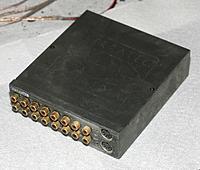 Views: 189
Views: 189 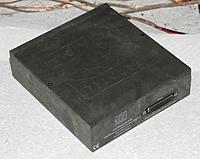 Views: 181
Views: 181 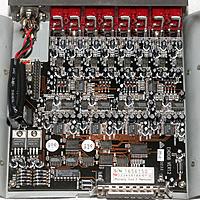 Views: 195
Views: 195 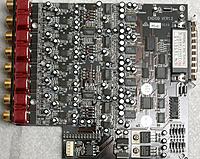 Views: 167
Views: 167 